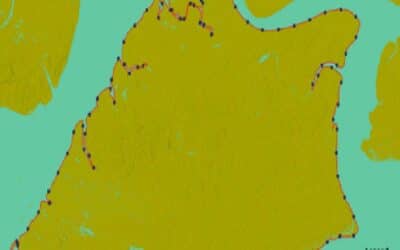GIS Tools and Consolidation Boost SEC Performance
Saudi Electricity Company (SEC) is the sole company managing electricity from generation to distribution in the Kingdom of Saudi Arabia (KSA). SEC serves over 11 million customers. It owns and manages more than 70,000 kilometers of electric transmission lines and over half a million kilometers of distribution lines. It is one of the largest companies in the Middle East/North Africa (MENA) region.
Challenge
SEC was formed by the merger of several regional electric utilities. While their functions were consolidated, some decentralized functions, practices, and technologies remained in the various regions. Prominent among them was the implementation of geographic information system (GIS) technology. While the systems were mainly based on Esri’s ArcGIS, the data models, application software, data governance, workflows, and software versions varied from region to region.
These inconsistencies led to a host of challenges. Employees who used the GIS from one region would require significant training to move to another. Integration with corporate systems, which were increasingly centralized, continued to be problematic. Having different systems with different standards was expensive and inconvenient. However, dealing with end-user issues was the more difficult challenge for the company. When they reported a problem, the time required to resolve it could be many hours—or, in some cases, days. Since each region had its own GIS data center, even the management of the data centers needed custom attention. This situation led to dissatisfied users and a reduction in productivity.
Solution
Over the last decade, SEC continued building its GIS expertise. The company recognized that this technology was a critical element in the modernization of the grid. It had three problems: First, the separate GIS implementations inhibited the vision of an enterprise system designed to drive the company’s digital transformation. Second, the lack of geospatial enablement of corporate systems inhibited risk assessment and other key analytical abilities. Third, data management was spotty and needed to be managed centrally.
The solution was simple to state but challenging to accomplish: to consolidate all GIS implementations into one. In addition, SEC needed a way to monitor the system centrally. That involved establishing a simple yet comprehensive way of quickly diagnosing issues as they are reported. The solution was to install ArcGIS Monitor.
The following consolidation was required:
- Standardizing workflows
- Adopting a single data model
- Moving to a single data center
- Deciding on a single overarching suite based on Schneider Electric’s ArcFM products
- Implementing a standardized data governance policy and set of practices
“We recognized that if SEC were to fully leverage the power of GIS as a comprehensive system of record, engagement, and insight and provide the performance our employees required, we needed to consolidate and establish a strong monitoring process.”
Mohmmad AlJedani, GIS Division Manager at Saudi Electricity Company
Results
The consolidation took one year to complete. SEC made significant efforts to involve the GIS support staff and users in the various regions. Having disparate groups with their own ideas on the data model was a huge change management problem. However, involving the parties early on and illustrating the benefits of consolidation and centralized resolution provided a strong backdrop for success.
 ArcGIS Monitor provides easy-to-use reports that graphically illustrate performance.
ArcGIS Monitor provides easy-to-use reports that graphically illustrate performance.
One of the strongest results was adopting ArcGIS Monitor. It has the ability to assess issues quickly, often before end users raise problems. It is designed to collect, analyze, and optimize the health of the combined SEC GIS. Implementing ArcGIS Monitor in each of the disparate regions would have been difficult and would not have provided the results desired by the company. ArcGIS Monitor delivered timely and actionable insights on status, availability, usage, system performance, and resource utilization. It provided the GIS support team real-time notifications when measurements were outside defined system thresholds. Dashboards provided rapid visualization of issues.
 Real-time performance graphs allow for rapid resolution of issues.
Real-time performance graphs allow for rapid resolution of issues.
The Team
The Saudi Electricity GIS organization led the implementation team with support from Esri Saudi Arabia and Esri corporate professional services. Each worked closely with SEC to successfully consolidate and migrate the data into the standard data model.
“Harnessing the power of ArcGIS Monitor gave us the ability to respond to our users in record time.”
Mohmmad AlJedani, GIS Division Manager at Saudi Electricity Company
Benefits
Despite the substantial increase in the size of the consolidated geodatabase, performance has increased. The adoption of ArcGIS Monitor has reduced the resolution time from an average of a day and a half before consolidation to a stunning result of 10 to 15 minutes. The other benefit is the huge reduction in end-user complaints about problem resolution, performance, and ease of use. Of course, change management is always an issue, but the positive results have won over even the most vocal critics.
One additional benefit is the increased adoption of GIS technology at SEC. Now there can be more sharing across regions and more innovation.
Next Steps
Plans are in place to move to ArcGIS Utility Network. Currently, there continue to be two GIS implementations. The consolidated GIS serves the distribution network. The other is for National Grid SA’s transmission grid. Combining transmission and distribution GIS into a single system allows better visibility into the entire kingdom’s electric system. Once consolidated, SEC can implement a countrywide electric system portal, including generation facilities. In addition, this consolidation will allow the GIS teams to use ArcGIS Monitor for the entire grid. SEC is currently using ArcGIS Monitor 10.8.1. The plan is to eventually move to ArcGIS Monitor 2023.
Finally, the team is examining adding the SEC private telecommunications network to the GIS.
